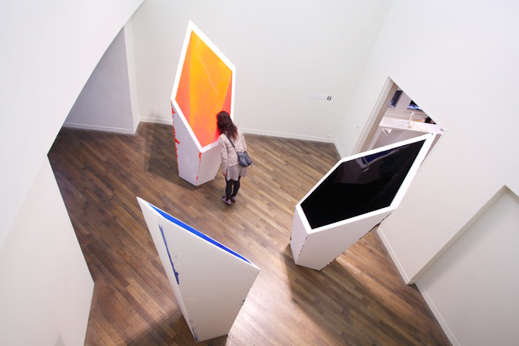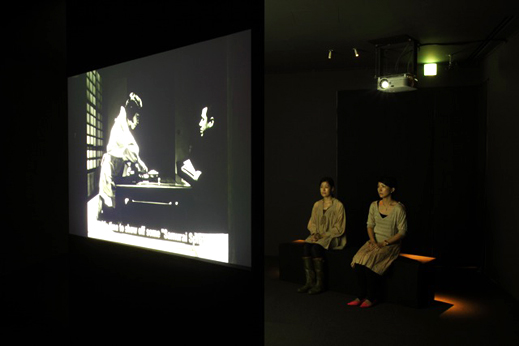 |
Focus features two in-depth reviews each month of fine art, architecture and design exhibitions and events at art museums, galleries and alternative spaces around Japan. The contributors are non-Japanese art critics living in Japan. |
|
|
 |
 |
 |
Poetics of Space
Roger McDonald |
 |
 |
| Jan Scharrelmann (clockwise from yellow work): Happy Hole I (2011), Black Hole I (2011), Happy Hole II (2011); all epoxy, resin, styrofoam and pigments. |
Twenty years ago, in 1991, the Daimler Group began an artist-in-residence program called Art Scope. Initially only involving Japanese artists traveling and living in France, from 2004 Art Scope became an exchange residency between Japan and Germany, with artists staying in Tokyo and Berlin respectively. Among the many artist residency programs in Japan, Art Scope is unique for being a corporate-sponsored program as well as for its now historic vision, which has spanned two decades and numerous artists.
Invisible Memories shows new works by four artists from the most recent exchange: the Germans Eva Berendes and Jan Scharrelmann and the Japanese Hiroe Saeki and Meiro Koizumi. Each spent time in Tokyo or Berlin respectively. Installed throughout the rooms of the Hara Museum in Tokyo, this exhibition feels as if it has emerged out of, or evolved towards, the intimate spaces of the museum, a former residence. The exhibition draws on this past and adds to it, but without a literal didacticism of "domesticity."
Jan Scharrelmann's styrofoam and epoxy resin sculptures stand like massive vases in the entrance gallery. Eva Berendes presents painted silk fabrics hung on the walls and standing sculptures made out of perforated metal sheets that look like partition screens. In both Scharrelmann's and Berendes's sculptures there is a concern with insides and outsides, as well as with the human ability to perceive multiple things at once, and how this is registered in our brains. The home is, after all, one of the most powerful devices for generating complex internal and external spaces, as the wonderful writings of Gaston Bachelard recount.
 |
| Meiro Koizumi: Defect in Vision (installation view at Hara Museum, 2011); two-channel video installation. |
Hiroe Saeki's delicate pencil and acrylic drawings on paper look like dream-images comprising grasses, tree branches, seeds, and the ground. They appear to be visual translations of Saeki's emotions and feelings during her Berlin stay, amplifying or re-tuning specific aspects. Small encounters, glances, or memories of a certain kind of light are processed into curved lines and other shapes.
Meiro Koizumi presents a two-channel video installation titled "Defect in Vision." Showing a conversation over a chabu-dai table in a Japanese interior, two blind people talk about the war (World War II), whether it will end soon or drag on, and how nice it will be to visit a hot springs bath together. The man "reads" a newspaper, while his wife arranges pickles and tea on the table. It is a domestic scene that doubtless occurred thousands of times during the 1940s. The dining table becomes the focus of state power, media knowledge, hope, family love, and nourishment. Meiro's catalogue comment includes a quote from an anonymous worker at Fukushima's stricken nuclear power plant, who told his wife and child that he was not going to the reactor, to put their minds at ease.
Invisible Memories is a strong exhibition that resonates with its space. Each work intelligently -- perhaps unconsciously -- echoes with its immediate place. Some achieve this on more formal terms through textures, materials and careful combinations of shapes. Others use narrative devices and images from everyday life to evoke specific emotions or moments. A home is perhaps something rather like this: a place which literally "fills up" with the memories and traces of those who have lived there or passed through. Homes have a strange capacity to "speak" of these things through their material forms, smells, colors, and ambiance. That Invisible Memories is an exhibition related to artists' residency experiences makes this all the more pertinent.
 |
Eva Berendes: (near textile) Untitled (2010); silk, paint; (far work) Untitled (2010); metal, brass, varnish.
All photographs by Keizo Kioku, 2011
|
|
 |
 |
Roger McDonald
Roger McDonald was born and brought up in Tokyo, educated in the UK, and returned to live in Japan in 2000 after completing his PhD. He has worked on the Yokohama Triennale 2001 as assistant curator, the Singapore Biennale 2006 as curator, and organised a number of exhibitions and projects independently. He is deputy director of the non-profit curatorial collective Arts Initiative Tokyo, and teaches at Musashino and Joshibi Art Universities. |
|
 |
|